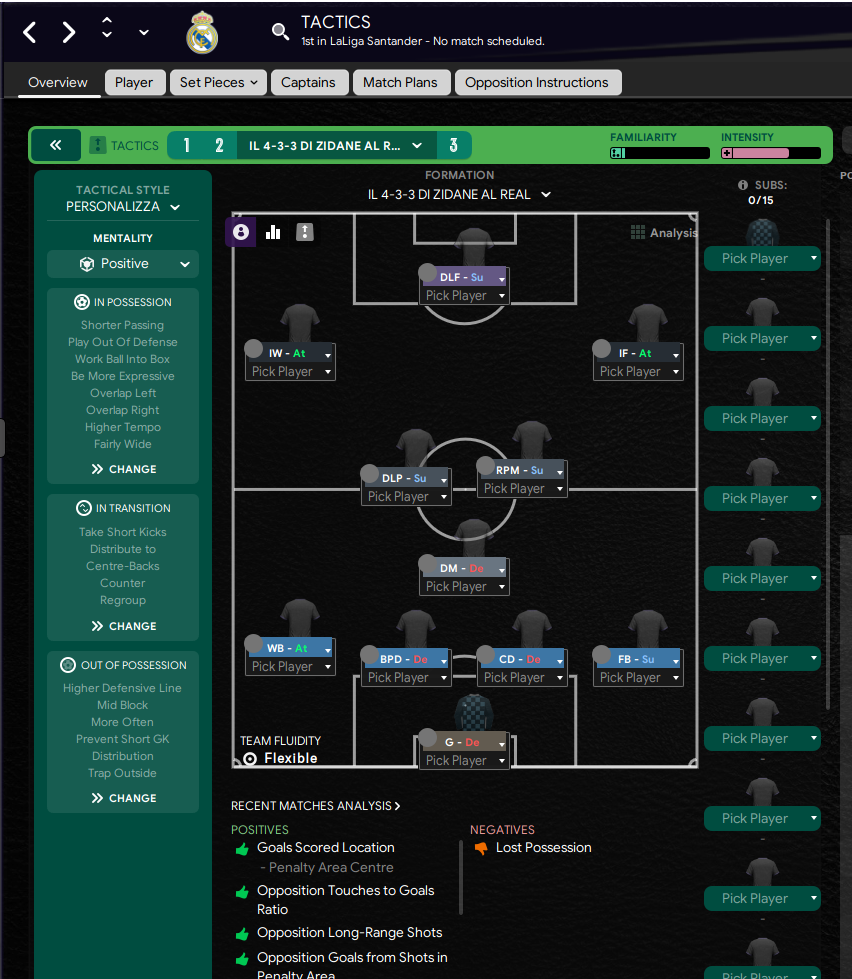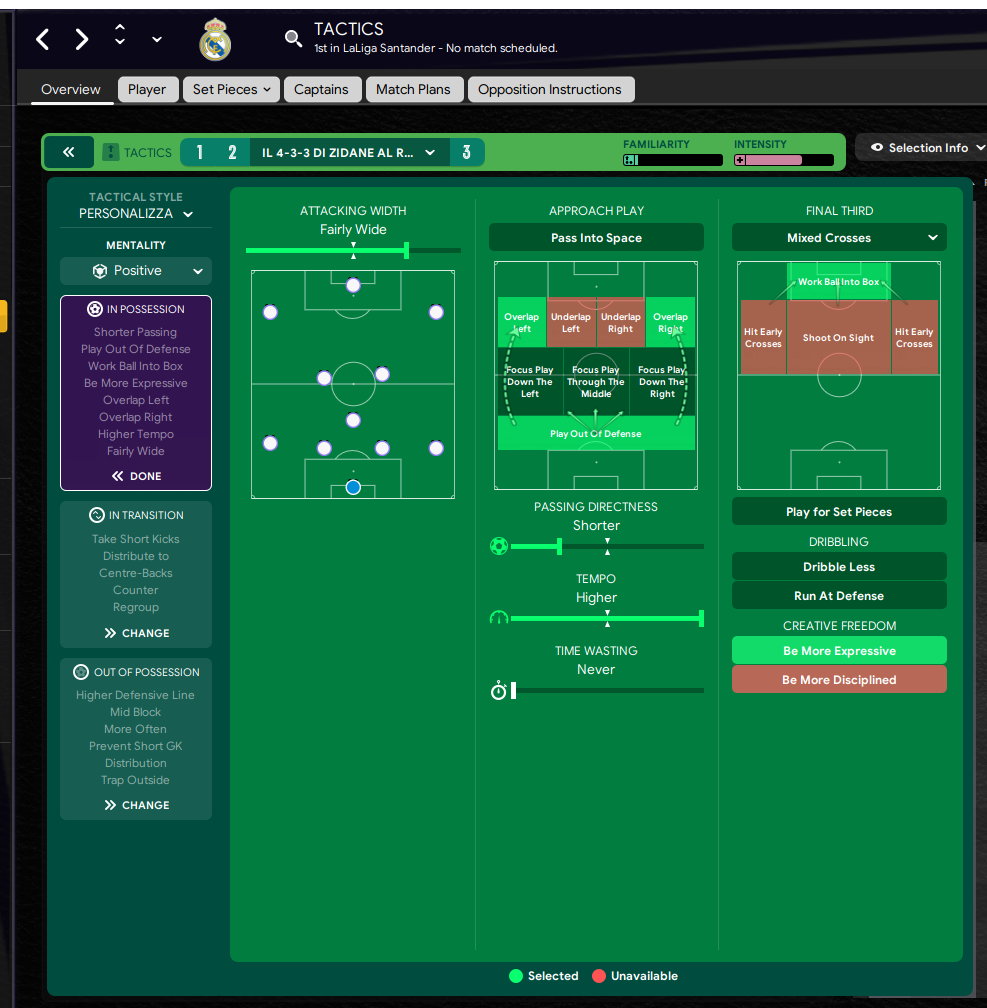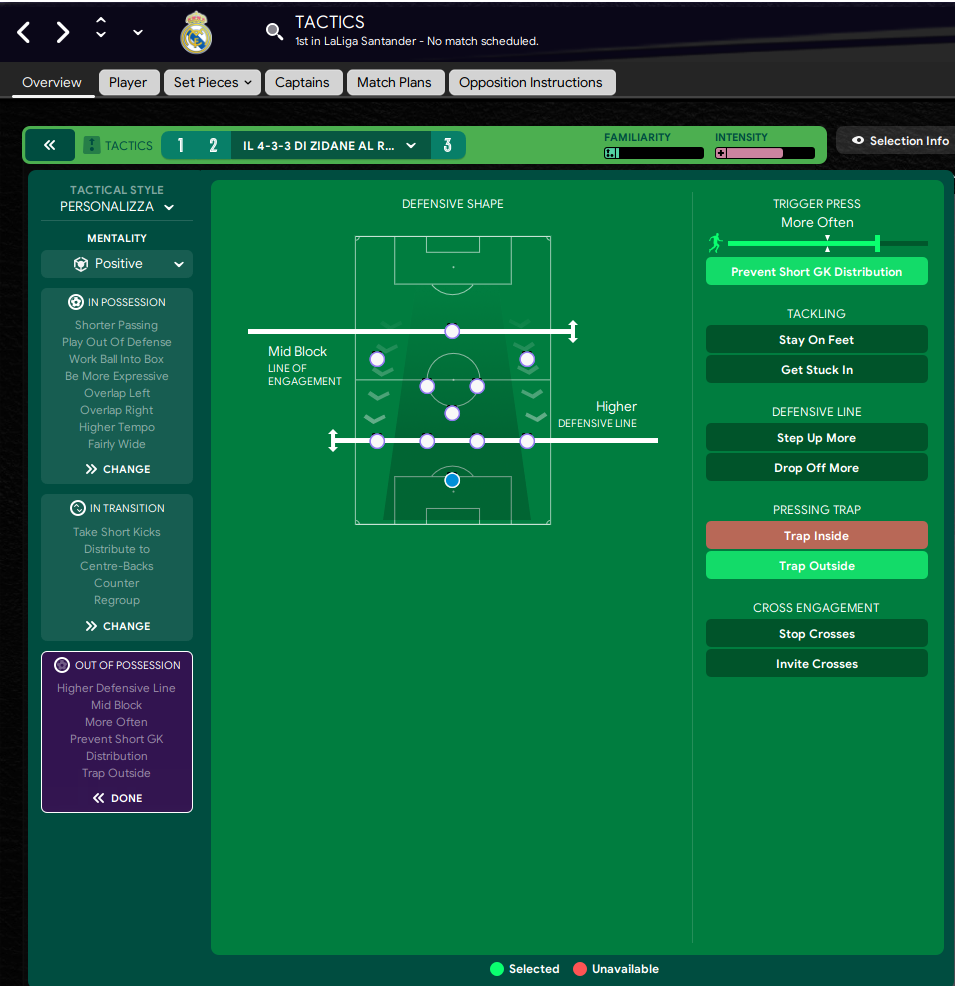| Tester | Team | ME | Win % | PPG | AGF | AGA | GD | PL | W | D | L | |
|---|---|---|---|---|---|---|---|---|---|---|---|---|
| Deleted User #1866315 |
 Real Madrid
Real Madrid
|
23.5.0 | 76% | 2.5 | 2.3 | 0.4 | 1.89 | 38 | 29 | 8 | 1 |
Hi guys, this is my attempt to emulate Zidane's 4-3-3 he used at Real Madrid. I made his 4-1-2-1-2 he used in the last part of 2017-18 season too, I will post it later.
First of all, I studied this analysis made by professional analysts of the italian site assonalisti.it
This is the link. https://assoanalisti.it/analisi-tattica-real-madrid-zinedine-zidane/
It's in Italian, I translated it into English for you. I apologize if my English is not perfect, but I will work hard to improve it.
Depending on the interpreters, Zidane chooses to manage the build-up and finishing phase differently.
With the 4-2-3-1 formation, the build-up phase relies on a midfield with two players, usually Kroos and Modric (or Kovacic), who play on the same line. Their task is to trigger the attacking midfielders' line, with Cristiano Ronaldo positioned on the left, one of James Rodriguez or Isco in the middle, and Gareth Bale on the right (replaced by Vazquez following the Welshman's ankle injury). The center-forward is always Karim Benzema, seldom replaced in the starting lineup by the former Juventus player, Morata.
With the 4-3-3 formation, the game's construction changes radically. The defensive midfielder, Kroos, becomes the focal point of the game and drops between the two central defenders when the team starts the ball circulation from the defense. Next to him, two central midfielders typically act, with Modric on the right and Isco on the left. In front, the attacking trio consists of Ronaldo on the left, Benzema in the center, and either Bale or Vazquez on the right.
In possession of the ball, Real Madrid develops the game with ball circulation from the back. Kroos drops between the two central defenders, who widen to provide width and seek play on the flanks. Unlike many Spanish teams, including Barcelona, the ball circulation is not exaggerated. The key concepts of the "merengue" (Real Madrid) game are the search for wide players and vertical passes into space, triggering the speed of the forwards available to the Casa Blanca (Real Madrid). Zidane has perfectly understood the human resources at his disposal and has chosen to emphasize two fundamental characteristics: speed and technique. By combining the excellent basic skills of his players with their physical and athletic performances, he has chosen to play a no-frills style of football. Ball possession is a means to attack the depth, often with passes coming from the full-backs, as seen in Benzema's goal against Athletic Bilbao. The position of the French center-forward, Karim Benzema, is particularly interesting. In the collective imagination, he is a striker who plays on the depth and likes to stay in the penalty area. Zidane has modified his attacker's tactical approach, asking him to make movements that generally don't align perfectly with those of a traditional number 9. Benzema, in fact, despite starting from a central position, tends to roam and move towards the left side of the Madrid attack, thereby favoring Cristiano Ronaldo's cutting inside. This highly intelligent move is aimed at disorienting the opposing center-backs, who might be tempted to follow Benzema's movement, and facilitating the run of the Portuguese number 7, who is launched with speed towards the center of the penalty area.
The same applies to the wide midfielders, especially Isco. Opponents tend to surround the ball carrier, who now has two options: one-on-one play or a pass. Attacking depth from a wide midfielder is one of the most frequently used options by Real Madrid, with the exception of Cristiano Ronaldo, who particularly enjoys one-on-one situations.
The Portuguese superstar is the "surprise" element in Zidane's offensive play. While it's known that he starts from the left, he also loves to cut inside and switch to the opposite side of the attack, exchanging positions with another speedster like Bale, as seen in the third goal scored at the Vicente Calderon against Atletico Madrid.
We are talking about an absolute superstar, and we know that well. However, it's interesting to highlight some significant numbers to demonstrate that Cristiano Ronaldo manages to centralize the offensive play of Zidane's Real Madrid.
By the numbers, he is the player with the most goals scored, but that's not the only statistic to focus on. Let's take the official UEFA statistics, analyzing matches in the UEFA Champions League where the technical and tactical level of the opponents is higher. CR7 turns out to be the player who shoots the most towards the goal (33 shots in 6 matches, an average of 5.5 attempts per game), both from inside and outside the penalty area.
So far, we have looked at the offensive characteristics of Real Madrid, but it's in the defensive phase that Zidane, in my opinion, has brought the most innovations. This is where his Italian influence becomes evident because the defensive phase is extremely well organized and reliable. Without giving up on attacking, Real Madrid remains a team with great balance. This is due to the filtering work done by the midfield, but also, and above all, the tactical attitude that Zidane has instilled in his players. Density around the ball and pressing on the ball carrier are the main principles of Real Madrid's defensive phase, where all players participate in both phases of the game.Within about 25 meters, all 10 outfield players available to the Marseille coach are enclosed. This defensive setup creates very few spaces for the opponents to exploit. This defensive approach forces opponents into just two options: either play the ball backward and lose ground or attempt one-on-one situations to regain numerical equality or superiority. This defensive attitude proves to be particularly effective, considering that Real Madrid is one of the teams that has committed the fewest fouls in this UEFA Champions League season.The density around the ball, in fact, allows Zidane's players to contain the opponent's build-up and avoid succumbing to lethal counter-attacks.This last statement is particularly related to the offensive build-up phase. The search for vertical passes and runs allows Real Madrid to maintain defensive stability. For instance, in the match against Borussia Dortmund at the Westfalenstadion, the Blancos managed to contain the speed of Tuchel's BVB by denying them space to launch rapid counter-attacks. Zidane demands a significant effort from his attackers and midfielders. They must be quick and fast in the positive transition phase and offensive build-up, but at the same time, they must expend significant energy when the ball is controlled by the opponents. The forwards and wide midfielders act as the first line of defense, and doubling up on opponents is a systematic weapon to slow down or halt the advance of the opponents.
If the central zone is adequately covered, there may be some difficulty in containing the wide channels, especially on the left side where Cristiano Ronaldo operates. The challenges here are more evident, not necessarily due to a lack of coverage by the reigning Ballon d'Or winner, but rather because of the characteristics of the left-back, Marcelo. The Brazilian, who has improved significantly in defense over the years, still struggles a bit in one-on-one situations, as seen in the goal conceded against Athletic Bilbao at the Bernabeu.
It's often said that great players don't necessarily become great coaches. While this statement holds true in some cases, it doesn't apply to Zinedine Zidane. In less than a year, he has achieved success and convinced many, imprinting a very personal style on his Real Madrid team. He hasn't been overwhelmed by the weight of responsibilities or the demanding standards of the Bernabeu, accustomed to seeing numerous attacking players on the field. Zidane has indeed found the right balance between quality and equilibrium, giving a strong identity to the defensive phase, which is organized and disciplined, while also adding his personal touch to the organization of the attacking play. The latter fully exploits the significant individual talents in the Real Madrid squad but is meticulously structured to attack spaces vertically with speed and quality.
EMULATION OF ZIDANE’S TACTIC
IN
FOOTBALL MANAGER 2023
Let's see now how I create this 4-3-3 from scratch on Football Manager.
First of all, these are for me the general steps you can follow to create this tactic:
1. Formation: Consider using a formation that allows for versatility and balance. Zidane used a 4-3-3 formation, but you can adapt it based on the squad you're managing.
2. Playing Style: Set your team's playing style to" Positive" to strike a balance between attack and defense.
3. Team Instructions:
⦁ Build-up Play: focus on shorter passing, instruct the team to play out of defense to encourage ball circulation from the back.
⦁ Higher Tempo: it is not a slow-pass tikitaka style tactic, possession is aimed to verticalize more
⦁ Encourage your players to exploit the flanks, make use of overlapping full-backs (Marcelo overlaps more than Carvajal) and play wide to stretch the opponent’s defense.
⦁ In Transition: use counter-press to the win the ball quickly after losing it. About the “counter” instruction, Real Madrid did fast counter-attacks but it was not always the case, the players chose it according to the situation so I will leave this instruction unchecked.
⦁ Out of Possession: employ a high defensive line and high line of engagement (press high up) to reduce the opponent’s time and space, press your opponents aggressively (so you can use the instruction “get stuck in” too but remember your players will get more yellow cards and red cards with it), prevent the opponent’s GK short distribution, trigger press more often (or even much more often. I suggest to start with “more often” and use “much more often” during the game if you are still struggling to get the ball). Use the instruction “stay up more” to do the offside trap and “trap outside” to force the opponents to play wider, near the touchline so that they will fewer options to play the ball. This will often result in the player with the ball having no options but passing the ball back to a teammate slowing down the play. Given the high density of our team in the areas close to the ball carrier and the ball itself, it will be easy for our team to win the ball back.
4. Player Roles and Instructions:
⦁ Goalkeeper: Keylor Navas was a simple keeper on defense, you can instruct him to take fewer risks or no instructions.
⦁ Center-backs: in Zidane’s Real Madrid, they were Sergio Ramos and Varane. Even if Ramos often said he sees himself as a ball-playing defender, I want Kroos to be the focal point of the game when he drops down between the two central defenders. That’s why I chose two central defenders on defend duty. You can instruct them to take less risks and. most of all, to stay wider to leave enough space for Kroos when he drops down between them.
⦁ Full-Backs: set your left full-back (Marcelo’s role) to a Complete Wing-Back on attack duty to replicate the overlapping runs and attacking contribution of the Brazilian player. Instruct him to close down less, Marcelo did not care much of pressing the opponents. On the opposite side, Carvajal was also overlapping a lot but a bit less than Marcelo, you can set your right full-back as a Wing-Back on support or if you want to have more space to modify his personal instructions, a simple Full-Back on support may suit this role because Full-Back on Football Manager has fewer preset instructions than Complete Wing-Back and Wing-Back. Instruct him to take fewer risks. It’s not that Carvajal did not overlap to cross, he did a lot and he was the world’s best crosser at that time, but he played more carefully than Marcelo.
⦁ Central Midfielders: assign roles like Deep-Lying Playmaker to replicate Kroos and instruct him to pass shorter and hold his position. Kroos played in front of the defense and dropped down between Ramos and Varane to build the play from the back and to help the defensive phase. Next to him, on his right, there was Modric. Modric’s role can be replicated on Football Manager in two ways, one is the Roaming Playmaker (which is preset on support duty), you can instruct him to dribble more if you want to recreate the movements of this Croatian genius. The other option is the Central Midfielder on support duty, you have more room to change his playing style using personal instructions compared to the Roaming Playmaker role. If you choose this second option, you can instruct Modric to pass shorter and “hold position” and avoid the instruction “dribble more”. On Kroos’s left, there was Isco, you can assign him the mezzala role on attack duty, as mentioned in the tactical analysis, his deep attack created space for his teammates and he often got to the opponent’s box. Later, in March 2016, Casemiro started playing more and more often in the starting eleven, he took Kroos’s position in front of the defense while the German player moved to Isco’s previous position and played as a central (not in front of the defense) Deep-Lying Playmaker (you can set him on support duty this time). Casemiro was the shield in front of the defense so you can set him to a defensive midfielder on defense duty, instruct him to mark tighter, tackle harder and close down more. You can see this in the second version of my tactic.
⦁ Wingers: set your wingers to an Inside Forward on attack to encourage them to cut inside, especially Cristiano Ronaldo, when Benzema dropped down or moved wider to the left side, Cristiano Ronaldo cut inside and scored a lot of goals this way. Same goes for Bale on the other side. Benzema could move wide right too and Bale would cut inside and enter the box.
⦁ Striker: set your striker to a Deep-Lying Forward or a False Nine role to replicate Benzema’s dropping and linking play stile. Instruct him to shoot less often, this does not mean he will never shoot, it means that he will not attempt to shoot as soon as he gets the ball, he will wait for a better chance instead of try impossible shoot from long distance, and where there is no chance, he will pass the ball and link the play.
I made a video on youtube where you can see the results and the tactic in-game creation also for those of you who play on console and can't download the tactics here.
Test Results
 Real Madrid
Real Madrid
You'll need to Login to comment




